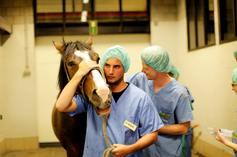Impact success story: Animal health
Veterinarians usually know the most about worm infections. Certain infections however do occur in humans. Scientists from the Faculty of Veterinary Medicine of Ghent University are developing new tests that will make a preventive approach easier for pigs. And that’s good news for people, too.
Peter Geldhof is a professor at the Faculty of Veterinary Medicine. When asked what his most important achievement is, the professor doesn’t hesitate one second: “Diagnostic tests for worm infections in pigs. We came upon our findings by accident, but immediately saw that there was a great deal of demand from practice. I say ‘by accident’ because we discovered the tests through fundamental research on pigs, and we even doubted ourselves whether there would be enough interest in them. To our surprise, it became a good example of something that sold itself.”

Sven Arnouts coordinates cooperation between the faculty and industry as a business developer. He remembers well how things used to be. “The tests now make it possible to work in a much more sustainable way. It’s a utopia to keep animals free of pathogens, but people weren’t even thinking along those terms 20 or 30 years ago. Animals such as chickens and pigs were frequently given antibiotics because they grew better that way. This is no longer allowed and fortunately it’s not necessary.”
Better prevent than treat with antibiotics
Peter Geldhof and his colleagues now work primarily towards prevention instead of treatment. The reason for this is simple: parasites can become resistant to anti-parasitic agents, just as bacteria develop antibiotic resistance. That’s why the researchers focus so heavily on monitoring.
Sven Arnouts: “We want to know what’s going on at a farm. Does the farmer have to give an antibiotic or can he use a vaccine? Or perhaps would a substance that strengthens immunity be sufficient? Also, we shouldn’t underestimate the importance of biosafety, for example, of good controls upon the entry of new animals and of keeping rodents and birds away on farms. These are the places where we need to stop pathogens to prevent infections from spreading.”
“It’s important to identify the animals that benefit from treatment. So in that area animal welfare is indeed an issue, as are the ecotoxic effect of medication on the environment and the fact that the medicines work longer if you use them sparingly and in a targeted manner.”
“This last point in itself is also beneficial in terms of animal welfare,” adds Sven Arnouts. “The World Health Organization (WHO) has drawn up a list of the most critical antibiotics. They did the same for animals. What did they find? The same classes are at the top for both humans and animals. This is why those antibiotics will be reserved for humans alone in the near future. This means that we have to make sustainable use of the resources that remain if we still want to be able to treat sick animals in the future.”
The researchers focus on livestock and pets that are important in Western Europe, such as cats, dogs, pigs and cattle. The diagnostic test that they developed for pigs searches for a worm that is also found in humans, especially in developing countries. Sven Arnouts: “Our veterinary knowledge can indeed also be useful for humans. People in the veterinary world now hold the most knowledge about worm infections because these types of afflictions have practically disappeared in humans in the Western world, thanks to improved sanitary conditions. This is why studies in this area were stopped at a certain moment; it was no longer economically interesting. But there are still 1.5 billion people worldwide, especially children, infected with worms. For five to ten years, a great deal of knowledge from the veterinary world has therefore been applied to combat worms in humans. The test we designed for pigs is now being used in children in African countries.”